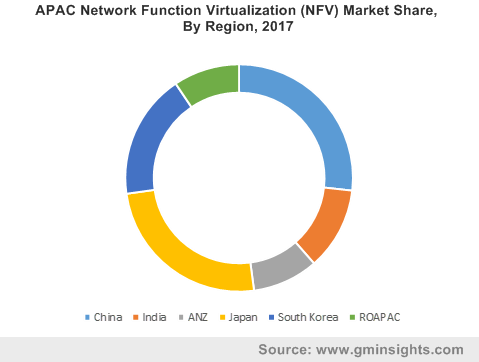Network function virtualization market to capitalize on massive IoT & 5G network deployment trends, Asia Pacific to emerge as an opportunistic hub for investors over 2018-2024
Publisher : Fractovia | Published Date : 2018-08-16Request Sample
Having taken prominent steps toward developing more agile & low cost network infrastructure, the global NFV market has been rightly placed as one of the lucrative spheres of the smart industry. Over the recent years, NFV has significantly reduced the investments in the hardware and networking components, thereby offering unprecedented commercialization potential to this business sphere. The technological advancements brought forth by the leading industry giants are further expected to scale up the NFV market trends in the ensuing years.
Europe Network Function Virtualization (NFV) Market Share, By Application, 2017

Recently, for instance, VMware Inc., has made it to the headlines for announcing its purchase of Dell EMC’s Service Assurance Suite to enhance its networking services. According to reports, the Service Assurance Suite comprises software for controlling & monitoring the health and performance of IT networks. The Suite is also expected to provide visibility and analysis to both the virtual & physical networks and cloud environments by identifying how exactly the resources are used and whether the service level agreements are being met satisfactorily. VMware revealed that the key plan is to integrate Dell’s technology into its NFV platform for telecommunication companies.
If industry analysts are to be believed, the addition of new capabilities would help the enterprises facilitate the impending deployments of 5G networks. With a number of carriers increasingly virtualizing core and edge networks with NFV, the global network function virtualization market is expected to accelerate at a commendable pace.
A report by Global Market Insights, Inc., further throws light on the growth prospects of this business sphere, claiming the overall network function virtualization market to record an outstanding growth rate of 42% over 2018-2024. The robust product demand from the IT and the telecom applications has been identified as one of the significant factors propelling the industry share. Estimates claim that the IT & telecom sector accounted for 32% of the overall NFV industry share in 2017. In a bid to reduce the dependency on dedicated hardware appliances, several IT network operators are adopting NFV for improved programmability and faster service enablement, in turn scaling NFV industry share from this application domain.
A number of operators are also using NFV in conjunction with advanced technologies such as VoLTE, Wi-Fi calling, and IoT. The alarming pace of the ‘Connected devices’ trend has in fact had an influential impact on the growth prospects of this business sphere, where the network infrastructure is required to be accommodated with adequate connectivity, while delivering application based services. This has in turn enabled the service providers to invest more in software network infrastructure as hardware are more prone to become quickly obsolete post the emergence of new technologies and could lead to huge recurring costs. NFV industry players, in accordance, are working actively toward technological upgradation that could solve bigger networking problems and create new dimensions in customer experience.
Speaking of the competitive hierarchy of the global NFV market, it is imperative to mention that the release and deployment of network function virtualization technology on the application level has proved to be rather successful for prominent industry players. However, the network administrators will be challenged in the near future to monitor the surge in demand for seamless automation solutions that would manage new devices powered with IoT, big data, and cloud applications. The leading NFV market players in this regard are expected to focus on R&D, collaboration, and product development & innovation strategies.
An instance validating the authenticity of the aforementioned is of the recent collaboration between the cable research organization CableLabs and engineering & design firm Aricent on an open NFV platform. Reportedly, the partnership is aimed at enabling a cloud-native environment for the laboratory and development work so that the developers can focus on their applications instead of virtual infrastructure. The duo also revealed that the proprietary SNAPS-Kubernetes NFV platform will mark its debut in the network function virtualization market in August, at the company conference to be held in Colorado. The release will significantly accelerate and simplify the adoption of NFV, while enhancing the quality of experience for end users, say analysts.
The scope of the expansion of the NFV industry is not only limited to the IT & telecom sector but also has huge growth potential from the healthcare, BSFI, retail, manufacturing, and government sectors. The heavy investments pertaining to the 5G technology implementation across myriad geographies is further poised to proliferate the regional growth of the global network function virtualization industry. For instance, the Asia Pacific NFV market is estimated to grow with the highest y-o-y rate of around 50% over 2018-2024, given the large-scale adoption of cloud-based computing technology by SMEs & business ventures & heavy investment in 5G testing and commercialization.
Having analyzed these trends, it wouldn’t be surprising to witness this industry bringing forth a paradigm shift in managing massive networks. While the global NFV market has just started to cross the chasm, it remains to see how this business sphere will unfold in the coming years. For the record, network function virtualization market size is set to cross the 70-billion-dollar frontier by 2024.